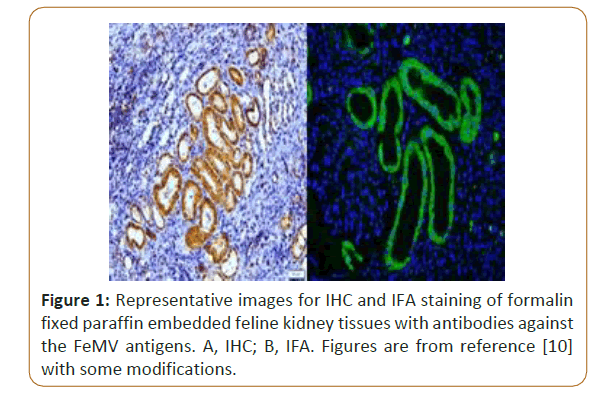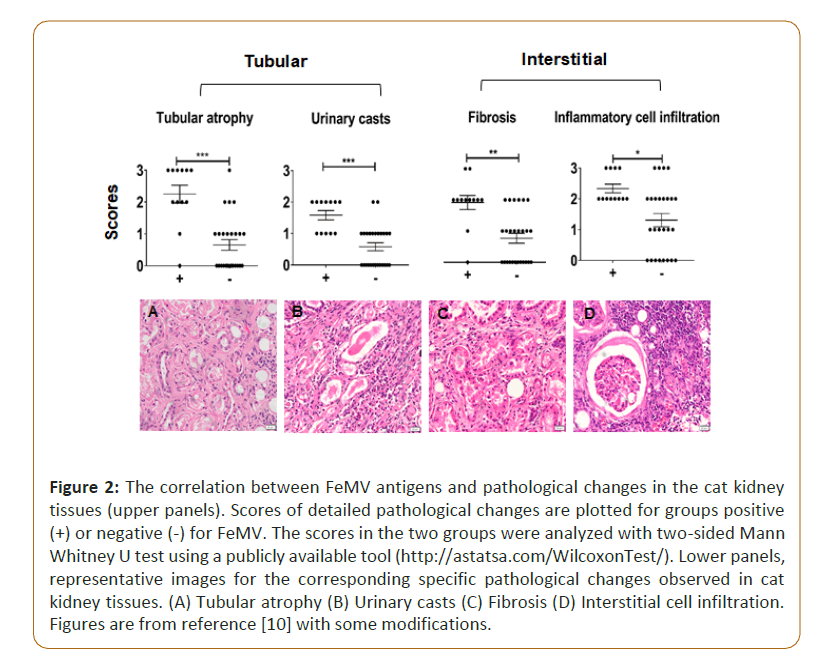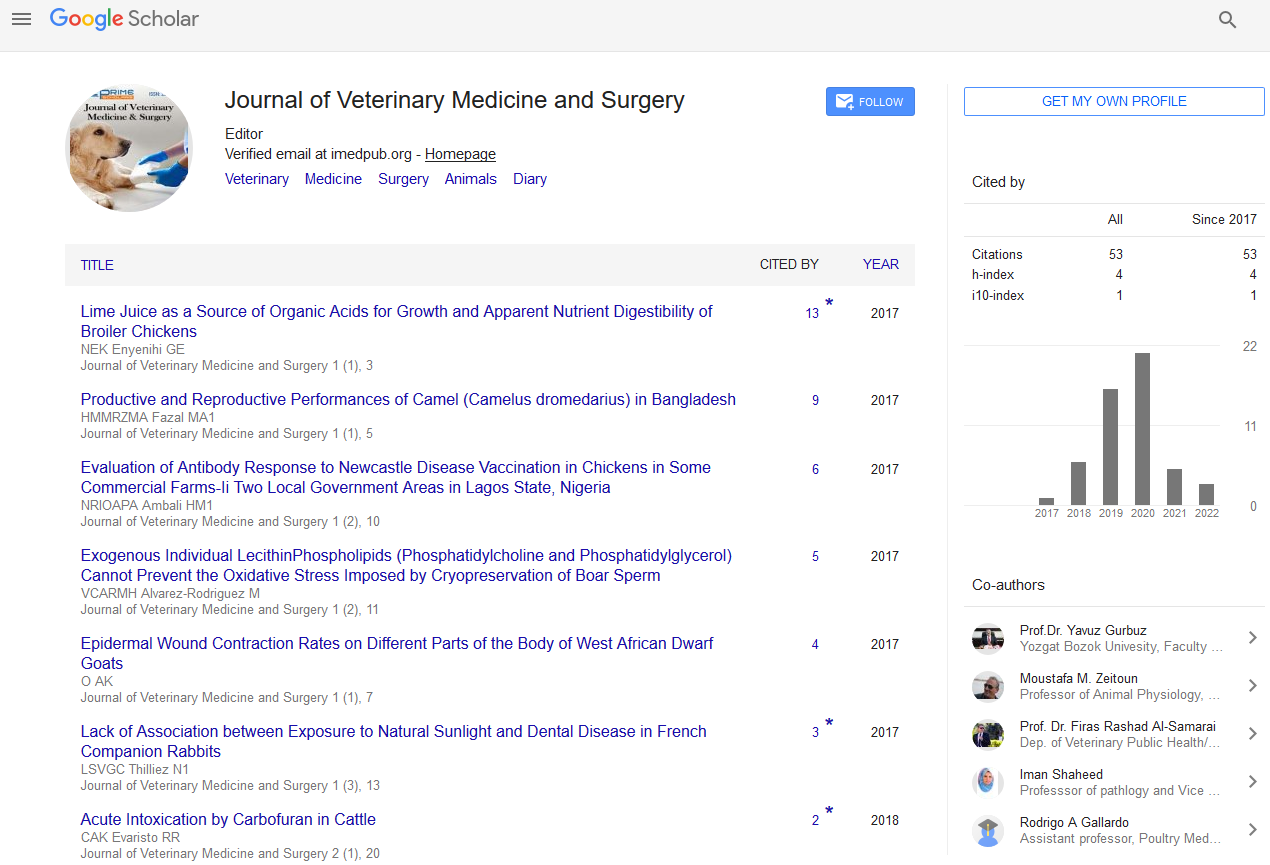Shwe Thiri Maung Maung Khin and Tetsuya Furuya*
Cooperative Department of Veterinary Science, Graduate School of Agriculture, University of Agriculture and Science, Tokyo, Japan
- *Corresponding Author:
- Tetsuya Furuya
Cooperative Department of Veterinary Science,
Graduate School of Agriculture,
University of Agriculture and Science,
Tokyo,
Japan,
E-mail: furuyat@cc.tuat.ac.jp
Received Date: March 29, 2021; Accepted Date: April 12, 2021; Published Date: April 19, 2021
Citation: Shwe TMMK, Furuya T (2021) Pathological Roles of Feline Morbillivirus Infection in Cat Kidney Tissues. J Vet Med Surg Vol.5 No.S1: 002.
Feline Morbillivirus (FeMV, originally named as FmoPV) was discovered in Hong Kong in 2012 and has been detected across different regions of the world since then. FeMV is officially classified as a member of genus Morbillivirus by the International Committee on Taxonomy of Viruses (ICTV), though its genome sequence is relatively distant from the other members in the genus, and has some distinctive biological characteristics, such as infection in kidney tissues and lack of known severe acute symptoms upon infection.
Keywords
Morbillivirus; Tubulointerstitial nephritis; Kidney tissue; Immunofluorescent assays; Fibrosis
Literature review
Although the association between FeMV infection and tubulointerstitial nephritis was suggested in the first report of FeMV detection, lack of correlation between detection of the virus and apparent clinical symptoms of kidney disfunction in cats was reported in subsequent reports of FeMV in other countries [1-8]. Therefore, it was important to find more clear evidence for whether FeMV infection involves in kidney diseases in cats, for the researchers interested in finding ways to prevent and treat kidney diseases in cats, which are unproportionally common for geriatric cats comparing to other animal species [9]. For this purpose, we aimed at obtaining the evidence of the link between FeMV infection and kidney tissue injuries in cats [10]. We obtained thirty-eight cat kidney tissues samples and determined their status of FeMV infection using Immunohistochemistry (IHC) and Immunofluorescent Assays (IFA) with specific antibodies against the FeMV N and M proteins as shown in Figure 1.
Figure 1: Representative images for IHC and IFA staining of formalin fixed paraffin embedded feline kidney tissues with antibodies against the FeMV antigens. A, IHC; B, IFA. Figures are from reference [10] with some modifications.
We also scored severity of their pathological changes in the different regions in the kidney tissues such as glomerular, tubular and interstitial tissues based on the observations of HE-stained tissue sections and compared the severity scores of the FeMVpositive samples to the negative ones as shown in Figure 2. As a result, we observed the severity scores were markedly higher in the FeMV-positive samples than the negative ones for multiple tissue lesions also explained in Figure 2, which were more eminent in the tubular and interstitial than glomerular legions. Such legions included tubular atrophy, luminal expansion, urinary casts, and inflammatory cell infiltration and fibrosis of interstitial tissues, many of which were common tissue damages seen in chronic kidney diseases [11]. Based on these findings, we concluded that the FeMV infection in the kidney tissues in cats were strongly associated with multiple pathological damages, and could contribute to chronic kidney diseases which are common in geriatric cats [9].
Figure 2: Different primal cuts parts of pork.
This study was the first report of the definitive contribution of FeMV infection to the kidney tissue damages with clear statistical evidences [10]. Since our report described above, there have been more articles published regarding association of FeMV with kidney disease in cats. In 2019, a feline Morbillivirus with 78% genome sequence identity to the previously reported FeMV was isolated from a urine sample from a cat with urinary tract symptoms in Germany and tentatively named as Feline Morbillivirus Genotype 2 (FeMV-GT2) [12]. Besides notably larger difference in the genome sequence from the one of the FeMV strains reported previously, FeMV-GT2 may have wider tissue tropism comparing to FeMV, since it could infect to immune cells including monocytes, B lymphocytes, CD4+ and CD8 T lymphocytes, brain slice culture of cerebellum and cerebrum, primary pulmonary cells, in addition to primary kidney cells [12]. Notably, small syncytia were observed in FeMV-GT2-infected brain slice culture cells, while no CPE was observed in any other infected tissue cells. This report suggests this distinct genotype of FeMV may have broader tissue tropism than previously reported FeMV, and may have some pathogenesis in central nervous tissues, which were common for other members of Morbillivirus, such as canine distemper virus and measles virus [3].
Subsequently, serological study was conducted for both genotypes of FeMV and FeMV-GT2 in free-roaming domestic cats in Chile using IFA [13]. They found 63% of seroprevalence to FeMV or FeMV-GT2, 24% and 9 % to FeMV only and FeMVGT2 only, respectively, and 30% to both the genotypes, although higher seroprevalence than previous studies might be due to the use of their newly developed IFA assay [13]. Using the same IFA assays, a larger FeMV-seroprevalence study with 840 serum samples from cats in Germany was conducted and demonstrated 49% of the samples were positive for antibodies against either FeMV or FeMV-GT2. Importantly, they also demonstrated higher creatinine levels in the donor cats seropositive for either FeMV or FeMV-GT2 than the FeMV-negative donor cats [14].
Finally, there are two reports about FeMV infection in the field species other than domestic cat. In Thailand, FeMV was detected in two black leopards in a zoo showing clinical chronic kidney diseases [15]. Gene sequences of the L gene of the detected FeMV was 98.2% identical to the one of the FeMV strain from domestic cats in Thailand. Based on their histological examination of the kidney tissues from the infected animals they observed prominent degeneration in the tubular epithelial cells where they detected FeMV antigens using IHC and IF assays with a FeMV- specific antibody. They detected the FeMV antigen in infiltrating lymphocytes in cytoplasm and histocytes of the spleen tissue of the infected black leopard. Another FeMV infection in non- domestic cat felid was reported in whiteeared opossums, wild felid species in Brazil [16].
Using RT-PCR for the L and N genes of FeMV with RNA extracted from lung and kidney tissues they detected the FeMV genes in 26% (6 /23) of the samples from the animals. Based on histological and immunohistochemical examinations they detected interstitial pneumonia in the lung tissues, and tubular interstitial nephritis/ tubular necrosis in the kidney tissues in 66.6% (4/6) and 50% (3/6) of the FeMV-infected opossums, respectively. They found that FeMV antigens were primarily localized in the cytoplasm of renal tubular epithelium in the kidney lesions and within the epithelial cells of the bronchus and peribronchial mixed glands on lungs. These findings suggest that FeMV infects some felid species other than domestic cat and may possess higher pathogenicity in some non-domestic cat felid species when infected. For this reason, we should study FeMV infection in animals of felid and non-felid species other than domestic cats, since FeMV infection may affect those animal species more severely than domestic cats.
Conclusion
In summary, despite some contradicting reports in early studies, more findings have been reported about contribution of FeMV infections to the clinical conditions in kidney and urinary tracts in domestic cats. Also, a genotype of FeMV was detected that exhibits distinctive tissue tropism and potentially distinctive pathogenicity. Cases of FeMV infections in different felid species from domestic cat were reported and may reveal different tissue tropism and pathogenicity of FeMV in these species from the ones in domestic cats. In addition to the importance in studies of common chronic kidney diseases of domestic cats, FeMV may affect other felid species in zoos and wild environments. Therefore, more studies are necessary not only for prevention and treatment of kidney conditions in cats, but for sustainment of animal ecosystem in the wild environment in the world.
References
- Woo PC, Lau SK, Wong BH, Fan RY, Wrong AY, et al. (2012) Feline Morbillivirus, a previously undescribed paramyxovirus associated with tubulointerstitial nephritis in domestic cats. Proc.Natl.Acad.Sci.USA 109:5435-5440.
- Choi EJ, Ortega V, Aguilar HC (2020) Feline Morbillivirus, a New Paramyxovirus Possibly Associated with Feline Kidney Disease. Viruses 12:501.
- De Luca E, Sautto GA, Crisi PE, Lorusso A (2021) Feline Morbillivirus Infection in Domestic Cats: What Have We Learned So Far?. Viruses 13:683.
- Furuya T, Sassa Y, Nagai M, Fukushima R, Shibutani M, et al. (2014) Existence of feline Morbillivirus infection in Japanese cat populations. Arch Virol 159:371-373.
- Park ES, Suzuki M, Kimura M, Muzutani H, Saito R, et al. (2016) Epidemiological and pathological study of feline Morbillivirus infection in domestic cats in Japan. BMC Vet.Res 12:228.
- Sharp CR, Nambulli S, Acciardo AS, Rennick LJ, Drexler JF, et al. (2016) Chronic Infection of Domestic Cats with Feline Morbillivirus, United States. Emerg Infect Dis 22:760-762.
- Darold GM, Alfieri AA, Muraro LS, Amude AM, Zanatta R, et al. (2017) First report of feline Morbillivirus in South America. Arch Virol 162:469-475.
- McCallum KE, Stubbs S, Hope N, Mickleburgh I, Dight D, et al. (2018) Detection and seroprevalence of Morbillivirus and other paramyxoviruses in geriatric cats with and without evidence of azotemic chronic kidney disease. J Vet Intern Med 2018 32:1100-1108.
- Lawler DF, Evans RH, Chase K, Ellersieck M, Li Q, et al. (2006) The aging feline kidney: a model mortality antagonist?. J Feline Med Surg 8:363-371.
- Sutummaporn K, Suzuki K, Machida N, Mizutani T, Park ES, et al. (2019) Association of feline Morbillivirus infection with defined pathological changes in cat kidney tissues. Vet Microbiol 228:12-19.
- McLeland SM, Cianciolo RE, Duncan CG, Quimby JM (2015) A comparison of biochemical and histopathologic staging in cats with chronic kidney disease. Vet.Pathology 52:524-534.
- Sieg M, Busch J, Eschke M, Bottcher D, Heenemann K, et al. (2019) A new genotype of feline Morbillivirus infects primary cells of the lung, kidney, brain and peripheral blood. Viruses 11:146.
- Busch J, Sacristan I, Cevidanes A, Millan J, Vahlenkamp TW, et al. (2020) High seroprevalence of feline Morbilliviruses in free-roaming domestic cats in Chile. Arch Virol 166:281-285.
- Busch J, Heilmann RM, Vahlenkamp TW Sieg M (2021) Seroprevalence of infection with feline Morbilliviruses is associated with flutd and increased blood creatinine concentrations in domestic cats. Viruses 13:578.
- Piewbang C, Chaiyasak S, Kongmakee P, Sanannu S, Khotapat P, et al. (2020) Feline Morbillivirus infection associated with tubulointerstitial nephritis in Black Leopards (Panthera pardus). Veterinary pathology 57(6): 871-879.
- Lavorente FLP, de Matos AMRN, Lorensetti E, Oliveira MV, Pinto-Ferreira F, et al. () First detection of Feline Morbillivirus infection in white-eared opossums (Didelphis albiventris, Lund, 1840), a non-feline host. Wiley 68:209-976.



